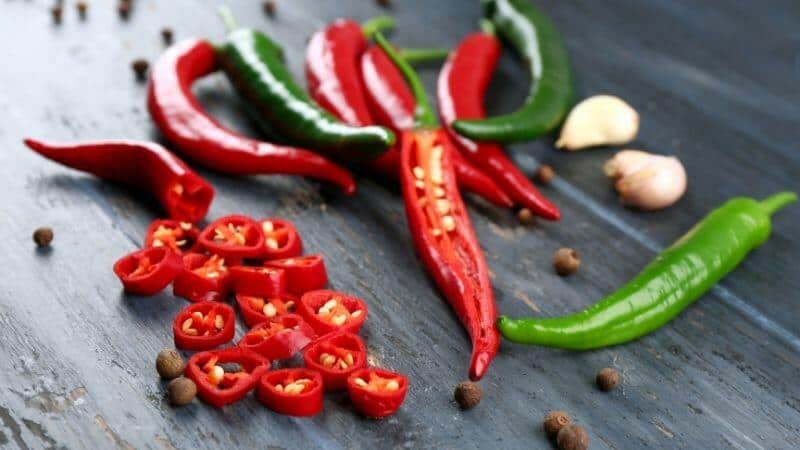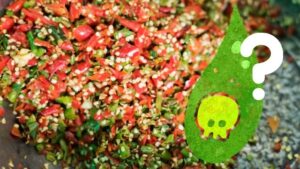Taken one too many bites of spicy buffalo wings and now your mouth is on fire? That burning sensation is thanks to a chemical called capsaicin found in chili peppers. So when will your suffering finally end?
The good news is that capsaicin’s burn is temporary. For most people, the worst irritation will fade within 20 minutes as your nerve receptors stop responding to capsaicin’s effects. However, factors like your
In most cases, capsaicin sensations start to fade within 20 minutes after exposure. However, the exact duration depends on factors like:
- Amount of capsaicin consumed
- Your personal tolerance
- What foods or remedies you use to relieve the burn
Read on to learn more about how capsaicin works, how long it takes to wear off, and what you can do to tame the flames faster.
What Is Capsaicin and How Does It Cause a Burning Sensation?

Capsaicin is the chemical compound in chili peppers and other spicy foods that gives them their signature heat and pungency.
It activates special nerve receptors in your mouth, eyes, and skin called TRPV1 receptors. When these receptors are triggered, they send pain and heat signals to your brain, creating a burning sensation.
This burning feeling is your body’s natural warning sign that you’ve consumed something dangerous. In nature, capsaicin helps deter animals from eating chili peppers so the plants can survive.
But humans seem to love the thrill of spicy heat, even if our initial reaction is to avoid it!
Why Does Capsaicin Burn Last Up to 20 Minutes?
Once capsaicin hits your TRPV1 receptors, it takes time for those activated receptors to stop signaling pain.
Here’s a play-by-play of what’s happening:
0 to 15 Seconds After Exposure
The capsaicin in the food rapidly binds to TRPV1 receptors in your mouth and throat as you chew. You’ll likely feel an immediate fiery blitz.
15 Seconds to 2 Minutes After Exposure
The burn intensifies as more receptors are activated by capsaicin. Your body also releases stress hormones like adrenaline and cortisol. You start sweating, and your face may redden.
2 to 10 Minutes After Exposure
The capsaicin finishes passing through your mouth and upper digestve tract. The burning sensation starts to slightly diminish.
10 to 20 Minutes After Exposure
Most of the capsaicin has been metabolized. The activated TRPV1 receptors start to deactivate and stop signaling pain.
20+ Minutes After Exposure
By 20 minutes, the majority of TRPV1 receptors are no longer being stimulated by capsaicin. The burning sensation substantially fades or disappears entirely.
Of course, spiciness levels vary wildly depending on the dose of capsaicin. But in general, 20 minutes is when relief kicks in.
The Afterburn Effect
Some people experience a “capsaicin afterburn” where they sweat and feel warmer hours after eating spicy food. This thermogenic effect results from increased fat oxidation and heat dissipation. It may last 2-4 hours as the body works to cool itself down through perspiration.
How Long Does the Burn Last with Capsaicin Contact Elsewhere?
Capsaicin doesn’t just burn your mouth – it can sting any sensitive areas of your body. Here’s how long irritation typically lasts if exposure occurs through:
- Eyes – After rubbing eyes while prepping chili peppers, the burning sensation may last 5 to 20 minutes before dissipating. Always wash hands thoroughly after handling peppers to avoid this scenario!
- Skin – When chopping spicy peppers, some people may experience a slight stinging or prickling where the pepper touched the skin. This generally goes away after 5 to 15 minutes.
- Ingestion – If you swallow capsaicin, it can irritate your throat and upset your stomach. Heartburn, nausea, or discomfort may be felt for 30 minutes to an hour before subsiding.
- Inhalation – Getting a whiff of potent chili pepper vapors may cause temporary nasal irritation, sneezing, or coughing which ceases within 15 to 30 minutes.
So while the mouth feel the brunt of the burn, capsaicin can temporarily irritate other areas too. But the good news is the discomfort is fleeting.
Factors That Influence How Long Capsaicin Burns Last
Why does your friend seem unaffected by habanero salsa while you need to chug milk after a small bite? Several key factors impact capsaicin sensitivity and burn duration:
- Dosage – Higher amounts of capsaicin lead to more TRPV1 receptors activated and longer-lasting burns. Even
spice lovers have a limit! - Tolerance – Frequent exposure to spicy foods makes nerve receptors less reactive to capsaicin over time.
- Genetics – Some people have more reactive TRPV1 receptors or lack enzymes that digest capsaicin quickly.
- Full vs empty stomach – Food helps absorb capsaicin while an empty stomach worsens irritation.
- Medications – Antiacids and blood pressure drugs may increase TRPV1 sensitivity, prolonging burn.
So the length of burn can range quite a bit between people. But for most, the worst will be over within 20 minutes – just stick it out!
4 Tips to Stop Capsaicin Burning Faster

There are a few tricks you can use to hasten relief if you’ve overdone it on the spicy salsa:
1. Drink Milk
Casein protein in milk products binds to capsaicin, helping deactivate it faster than water. Cold whole milk is ideal for dousing mouth burns.
2. Add Acidic Foods
Acids help break down capsaicin. A squirt of lemon juice speeds the recovery process. Tomatoes, vinegar, and citrus fruits work too.
3. Reach for Starch or Sugar
Starches and sugars pull capsaicin off receptors faster, reducing burn time. Bread, rice, or sugary candy can help here.
4. Use OTC Pain Relievers
For severe burns, oral numbing gels or anti-inflammatory pills provide targeted relief until capsaicin fades.
While nothing stops the reaction immediately, these tips can provide moderate relief and shorten your suffering by a few minutes.
Capsaicin’s Effects on Digestion
While capsaicin initially causes a burning sensation in the mouth, it can also irritate the stomach and intestines during the digestion process.
After being swallowed, capsaicin stimulates gastric juice secretions in the stomach. It also increases gut motility, causing food to move through the digestive tract more quickly.
For those with sensitivities, this can lead to symptoms like:
- Heartburn
- Nausea
- Stomach pain
- Intestinal cramps
- Diarrhea
These digestive effects may persist for 30 minutes to an hour before subsiding. People with conditions like GERD or stomach ulcers may experience more pronounced intestinal irritation after eating spicy foods containing capsaicin.
On the plus side, the boost to gastric secretions can help improve digestion and nutrient absorption. However, those benefits come at the cost of possible stomach discomfort.
So while the mouth burn may fade quickly, capsaicin can go on to cause secondary irritation throughout the gastrointestinal system for some time after a spicy meal. It’s important to monitor your individual tolerance levels.
Possible Long-Term Health Effects
While a painful irritant in the moment, capsaicin may have some potential long-term health benefits when consumed in moderation over time.
Research indicates capsaicin can:
- Reduce inflammation
- Improve cardiovascular function
- Provide pain relief from conditions like arthritis or neuropathy
- Support healthy digestion and gut bacteria
However, excessive intake of spicy foods may increase risks of:
- Stomach ulcers
- GERD (acid reflux)
- Irritable bowel syndrome (IBS)
- Stomach cancer
The key is moderation. Getting small doses of capsaicin through spicy foods may offer protective effects. But overdoing the heat on a regular basis can lead to health consequences.
Additionally, some medications like blood thinners and aspirin may interact with capsaicin, increasing clotting time or ulcer risk. Those with digestive conditions should be especially mindful of capsaicin intake.
While spicy food fans build tolerance, capsaicin can still damage tissue and exacerbate underlying conditions if eaten in excess over many years. Consulting your doctor is wise to find your ideal capsaicin dosage for long-term wellbeing.
The Takeaway on Capsaicin Burn Duration
In summary, the capsaicin burn from spicy foods usually starts fading by 20 minutes but can last longer depending on your:
- Tolerance levels
- Genetic factors
- Amount consumed
- Use of relief remedies
Though unpleasant, rest assured the worst won’t last forever. And over time, your
So next time your mouth feels scorched, breathe deep and soldier through knowing that relief will come soon. The lingering burn is just a sign you successfully conquered a good dose of spicy deliciousness!




